Python - 八大排序算法
1、序言
本文使用Python实现了一些常用的排序方法。文章结构如下:
1.直接插入排序
2.希尔排序
3.冒泡排序
4.快速排序
5.简单选择排序
6.堆排序
7.归并排序
8.基数排序
上述所有的排序均写在一个Python自定义类中,作为成员函数。
2、排序方法详细介绍
1.直接插入排序
直接插入排序(Straight Insertion Sort)是一种最简单的排序方法,它的基本操作是一个值插入到已排好序的有序表中,从而得到一个新的、记录数增1的有序表。如下图所示:
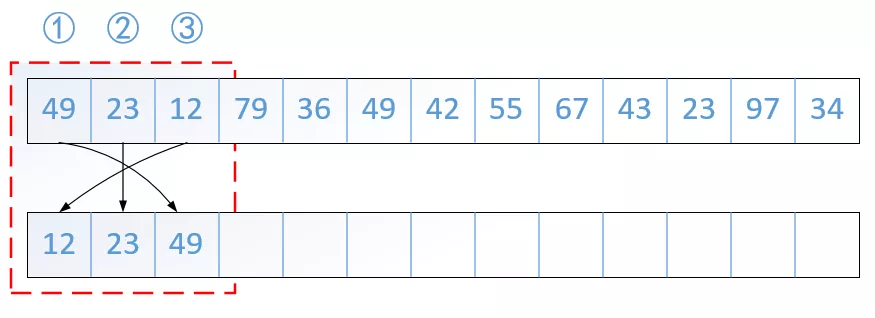
由上图可知若最初始的有序表即为数组的第一个元素。用Python实现如下:
- def straight_insertion_sort(self, value_list):
- """
- 直接插入排序
- :param value_list: 无序列表
- :return:
- """
- return self.__straight_insert(value_list)
- @staticmethod
- def __straight_insert(value_list):
- sorted_list = []
- sorted_list.append(value_list.pop(0))
- for i in range(0, len(value_list)):
- tail = True # 是否在尾部插入
- insert_loc = 0
- for j in range(len(sorted_list)):
- if value_list[i] <= sorted_list[j]:
- tail = False
- insert_loc = j
- break
- sorted_list.append(value_list[i]) # 先将值插入尾部
- if not tail:
- # 移动值
- for j in range(len(sorted_list) - 1, insert_loc, -1):
- temp = sorted_list[j]
- sorted_list[j] = sorted_list[j - 1]
- sorted_list[j - 1] = temp
- return sorted_list
2.希尔排序
希尔排序(Shell’s Sort)又称“缩小增量排序”(Diminishing Incerement Sort),它也是一种数插入排序的方法,但在时间效率上较前面的排序方法有较大的改进。它的基本思想是:先将整个待排记录序列分割成若干个子序列分别进行直接插入排序,待整个序列中的记录“基本有序”时,再对全体记录进行一次直接插入排序。如下图所示:
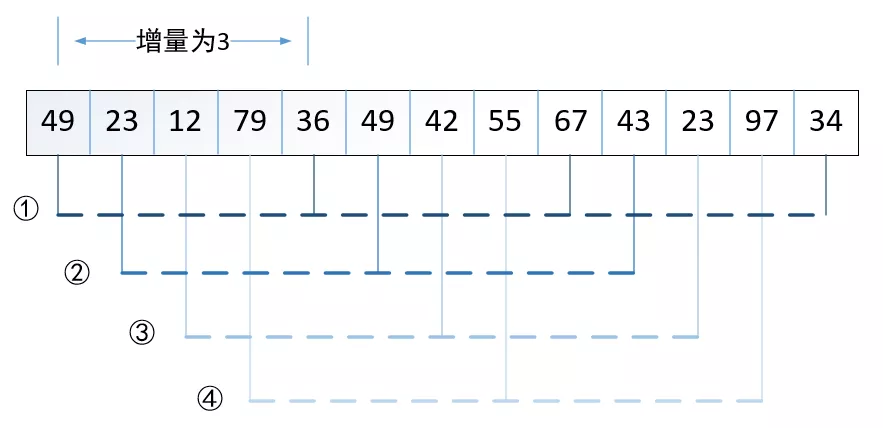
即根据增量将原序列分割成多个子序列进行直接插入排序。增量应不断减小,且最后一个增量为1。用Python实现如下:
- def shells_sort(self, value_list):
- """
- 希尔排序
- :param value_list: 待排序的无序列表
- :return: 排序后的列表
- """
- gap = len(value_list) // 2
- while gap >= 1:
- i = 0
- while(i + gap) < len(value_list):
- start = i
- gap_list = []
- while start < len(value_list):
- gap_list.append(value_list[start])
- start = start + gap
- gap_list = self.__straight_insert(gap_list)
- start = i
- while start < len(value_list):
- value_list[start] = gap_list.pop(0)
- start += gap
- i += 1
- gap //= 2
- sorted_list = value_list
- return sorted_list
3.冒泡排序
冒泡排序(Bubble Sort)的过程很简单。首先将第一个记录的关键字和第二个记录的关键字进行比较,若逆序(与需要的顺序相反),则将两个记录交换之,然后比较第二个记录和第三个记录的关键字,以此类推。为第一趟冒泡结束,接着对前n-1个记录继续进行上述的过程。这样重复的过程直至n-1=1结束。排序过程如下所示:

用Python实现如下:
- @staticmethod
- def bubble_sort(value_list):
- """
- 冒泡排序
- :param value_list: 待排序的无序列表
- :return: 排序后的列表
- """
- for i in range(len(value_list) - 1):
- for j in range(i + 1, len(value_list)):
- if value_list[i] > value_list[j]:
- value_list[i], value_list[j] = value_list[j], value_list[i]
- sorted_list = value_list
- return sorted_list
4.快速排序
快速排序(Quick Sort)是对冒泡排序的一种改进。它的基本思想是,通过一趟排序将待排记录分割成独立的两部分,其中一部分记录的关键字均比另一部分记录的关键字小,则可分别对这两部分记录继续进行排序,已达到整个序列有序。其排序思想如下:
首先任意选取一个记录(通常可选第一个记录)作为枢轴,然后按下述原则重新排列记录:将所有关键字较它小的记录都安置在它的位置之前,将所有关键字较它大的记录都安置在它的位置之后。一趟快速排序的具体做法是:设两个指针low和high,他们的初值分别为最低位置的下一个位置和最高位,设最低位置枢轴的关键字为pivotkey,则首先从high所指位置起向前搜索找到第一个关键字小于pivotkey的记录的枢轴记录互相交换。发生了交换后才从low所指向的位置起向后搜索,找到第一个关键字大于pivotkey的记录和枢轴记录互相交换。重复这两步直至low=how为止
如下图所示:

特别要注意换方向的时机是发生了交换后,用Python实现如下:
- def quick_sort(self, value_list):
- """
- 快速排序
- :param value_list: 待排序的无序列表
- :return: 排序后的列表
- """
- low = 0
- high = len(value_list) - 1
- self.__qsort(value_list, low, high)
- sorted_list = value_list
- return sorted_list
- def __qsort(self, val_list, low, high):
- """
- 快速排序辅助函数
- :param val_list: 无序列表
- :param low: 低位
- :param high: 高位
- :return:
- """
- if low >= high:
- return
- pivot_key = low
- temp_low = pivot_key
- temp_high = high
- while low < high:
- # 分成一边比轴(pivot)大,一边比轴(pivot)小的顺序
- while low < high:
- if val_list[high] < val_list[pivot_key]:
- temp = val_list[high]
- val_list[high] = val_list[pivot_key]
- val_list[pivot_key] = temp
- pivot_key = high
- break # 发生交换后,就换方向
- else:
- high -= 1
- while low < high:
- if val_list[low] > val_list[pivot_key]:
- temp = val_list[low]
- val_list[low] = val_list[pivot_key]
- val_list[pivot_key] = temp
- pivot_key = low
- break # 发生交换后,就换方向
- else:
- low += 1
- self.__qsort(val_list, temp_low, pivot_key - 1)
- self.__qsort(val_list, pivot_key + 1, temp_high)
5.简单选择排序
选择排序(Selection Sort)是一种简单直观的排序算法。它的基本思想是:每一趟在n-i+1(i=1,2,...,n-1)个记录中选取关键字最小的记录作为有序序列中第i个记录。简单选择排序:通过n-1次关键字的比较,从n-i+1个记录中选出关键字最小的记录,并和第i(1≤i≤n)个记录交换之。如下图所示:
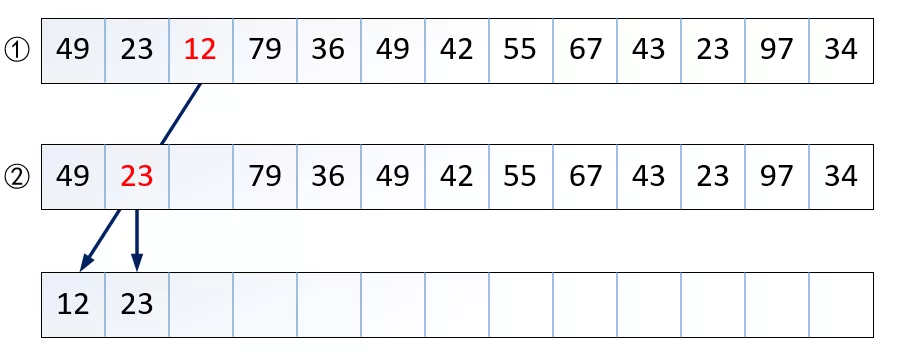
用Python实现如下:
- @staticmethod
- def simple_selection_sort(value_list):
- """
- 简单选择排序
- :param value_list: 待排序的无序列表
- :return: 排序后的列表
- """
- for i in range(len(value_list)):
- min_val = 9999999
- for j in range(i, len(value_list)):
- if min_val > value_list[j]:
- min_val = value_list[j]
- count = 0 # 如果有多个相同的最小值
- for j in range(i, len(value_list)):
- if min_val == value_list[j]:
- value_list[j], value_list[i + count] = value_list[i + count], value_list[j]
- sorted_list = value_list
- return sorted_list
6.堆排序
堆排序(Heap Sort)是指利用堆这种数据结构所设计的一种排序算法。堆的定义如下:
n个元素的序列{k1,k2,...,kn}当且仅当满足一下关系时,称之为堆。

若将序列看成是一个完全二叉树,则堆的含义表明,完全二叉树中所有非终端节点均不大于(或不小于)其左、右孩子节点的值。由此,若序列是堆,则堆顶元素必为序列中的最小值(或最大值)。如下图所示:
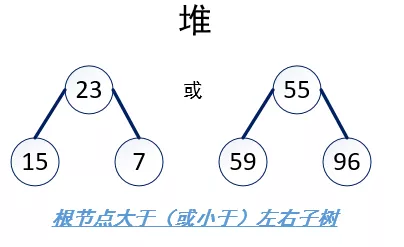
至此,我们可以给出堆排序的过程:若在输出堆顶的最小值后,使得剩余n-1个元素的序列又建成一个堆,则得到n个元素中的次小值。如此反复执行,便能得到一个有序序列。
故整个堆排序可以大致分为两个过程:
·将无序序列建成堆。
·输出堆顶元素后,用类似建堆的方法调整堆。
如下两个图所示:
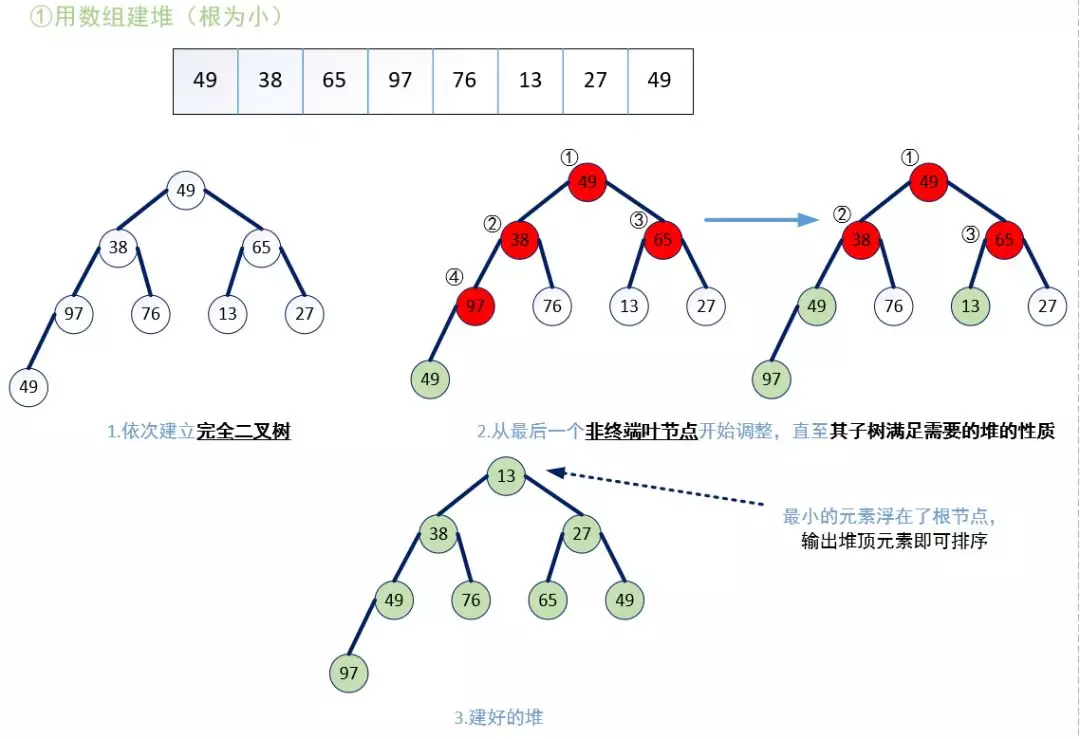
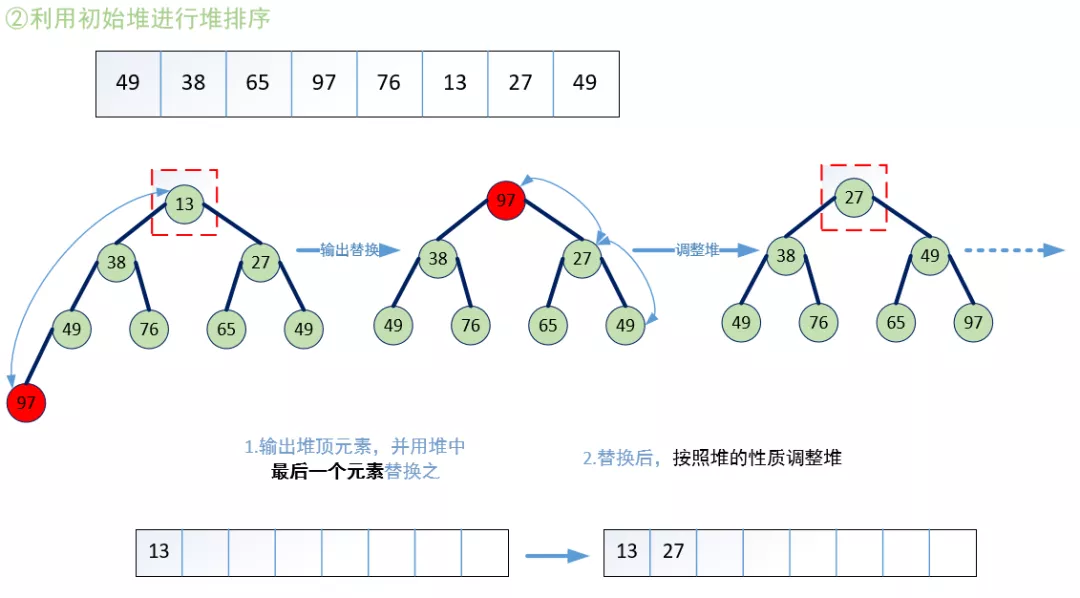
根据堆排序的特点总结出两点注意事项:
1.利用把堆看成完全二叉树的特点,用完全二叉树的性质解决算法问题。
2.建堆的过程是从树种的最后一个非终端节点逆序开始调整的。
3.每调整一次需要检查前后是否依然保持堆的特征。
本文利用了二叉树的孩子兄弟表示法来生成二叉树(堆)的。代码如下:
- class CldSibNode(object):
- """
- 私有内部类:孩子兄弟二叉链表节点
- """
- def __init__(self, val):
- self.value = val
- self.child = None
- self.sibling = None
- def heap_sort(self, value_list):
- """
- 堆排序
- :param value_list: 待排序的无序列表
- :return: 排序后的列表
- """
- sorted_list = []
- root_node = self.CldSibNode(None)
- self.__child_sibling(root_node, value_list, 0)
- for ct in range(1, len(value_list) // 2 + 1): # 建堆
- self.__adjust_heap(root_node, len(value_list) // 2 + 1 - ct, 1)
- for i in range(1, len(value_list) + 1): # 堆排序
- sorted_list.append(root_node.value) # 输出堆顶元素
- head = root_node
- self.__shrink_heap(root_node, len(value_list) + 1 - i, 1, head)
- self.__adjust_heap(root_node, 1, 1) # 调整堆
- return sorted_list
- def __child_sibling(self, node, value_list, ind):
- """
- 创建完全二叉树的左孩子右兄弟二叉链表
- :param node: 当前节点
- :param value_list: 待排序的无序列表
- :param ind:
- :return:
- """
- if ind >= len(value_list):
- return
- node.value = value_list[ind]
- if ind * 2 + 1 < len(value_list):
- node.child = self.CldSibNode(None) # 孩子
- self.__child_sibling(node.child, value_list, ind * 2 + 1)
- if ind * 2 + 2 < len(value_list):
- node.child.sibling = self.CldSibNode(None) # 兄弟
- self.__child_sibling(node.child.sibling, value_list, ind * 2 + 2)
- def __adjust_heap(self, root_node, last_ind, now_ind):
- if not root_node or not root_node.child: # 不为空且有孩子
- return
- if now_ind == last_ind:
- # 需要调整的非终端节点
- temp = root_node
- cg = False
- while temp.child:
- if temp.value > temp.child.value:
- temp.value, temp.child.value = temp.child.value, temp.value
- cg = True # 发生交换
- if temp.child.sibling:
- if temp.value > temp.child.sibling.value:
- if cg:
- # 如果发生过交换
- temp.value, temp.child.value = temp.child.value, temp.value
- temp.value, temp.child.sibling.value = temp.child.sibling.value, temp.value
- temp = temp.child.sibling
- continue
- else:
- if cg:
- # 如果发生过交换
- temp = temp.child
- continue
- break
- # 递归
- self.__adjust_heap(root_node.child, last_ind, now_ind * 2)
- if root_node.child.sibling:
- self.__adjust_heap(root_node.child.sibling, last_ind, now_ind * 2 + 1)
- def __shrink_heap(self, root_node, last_ind, now_ind, head):
- if not root_node or now_ind * 2 > last_ind:
- # 为空
- return
- if last_ind == now_ind * 2 + 1:
- head.value = root_node.child.sibling.value
- root_node.child.sibling = None
- return True
- if last_ind == now_ind * 2:
- head.value = root_node.child.value
- root_node.child = None
- return True
- if root_node.child:
- self.__shrink_heap(root_node.child, last_ind, now_ind * 2, head)
- self.__shrink_heap(root_node.child.sibling, last_ind, now_ind * 2 + 1, head)
7.归并排序
归并排序(Merging Sort),“归并”的含义是将两个或两个以上的有序表组合成一个新的有序表。假设初始序列有n个记录,则可看成是n个有序的子序列,每个子序列的长度为1,然后两两归并,得到[n/2]个长度为2或1的有序子序列;再两两归并,……,如此重复,直至得到一个长度为n的有序序列为止,这种排序方法为2-路归并排序。算法的基本思想如下图所示:
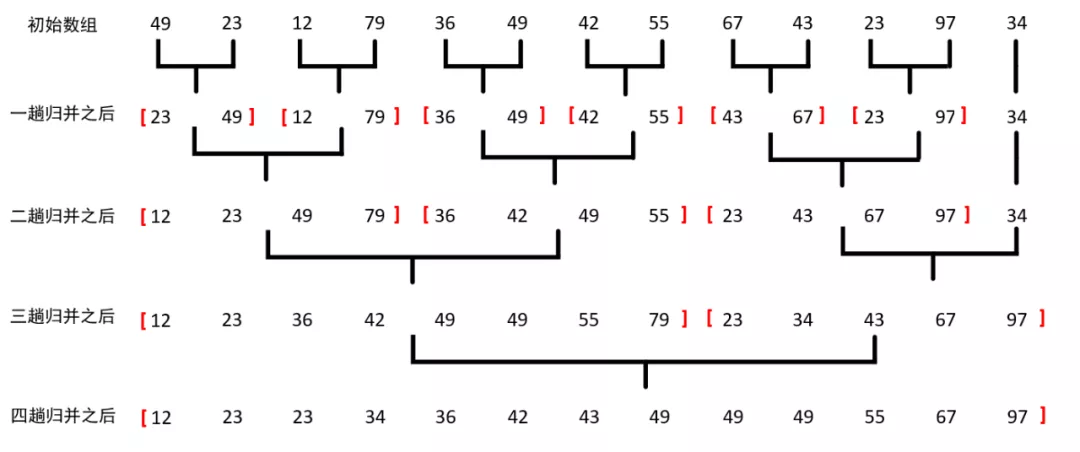
其中两个子序列的合并大有学问,基本思想就是:分别在两个序列头设置指针,比较两个序列指针所指的值的大小,将满足要求的值提取出来形成新列表,并将指针右移。当其中一个指针指向结尾之后时,表示其中一个列表已取尽,接着直接在新列表尾部连接另一个列表。如下图所示:
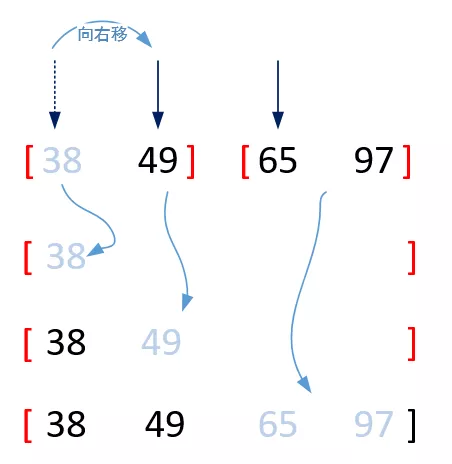
用Python实现如下:
- @staticmethod
- def merging_sort(self, value_list):
- """
- 归并排序
- :param value_list: 待排序的无序列表
- :return: 排序后的新列表
- """
- i = 0
- while np.power(2, i) < len(value_list):
- count = np.power(2, i)
- start = 0
- outer_temp = []
- while start < len(value_list):
- # 定位另一边
- other = start + count
- temp = []
- if other >= len(value_list):
- # 另一边不存在:直接合并
- outer_temp.extend(value_list[start: start + count])
- break
- left, right = 0, 0
- while left < count or right < count:
- if other + right >= len(value_list):
- # 右边提前结束
- temp.extend(value_list[start + left: start + count])
- break
- elif value_list[start + left] < value_list[other + right]:
- # 左边更小
- temp.append(value_list[start + left])
- left += 1
- if left == count:
- # 左边遍历结束
- temp.extend(value_list[other + right: other + count])
- break
- else:
- # 右边更小
- temp.append(value_list[other + right])
- right += 1
- if right == count:
- # 右边遍历结束
- temp.extend(value_list[start + left: start + count])
- break
- outer_temp.extend(temp)
- start += count * 2
- value_list = outer_temp
- i += 1
- sorted_list = value_list
- return sorted_list
8.基数排序
基数排序(Radix Sort)是一种非比较整数排序算法,其原理是将整数按位数切割成不同的数字,然后按每个位数分别比较。由于整数也可以表达字符串(比如名字或日期)和特定格式的浮点数,所以基数排序也不是只能使用于整数。
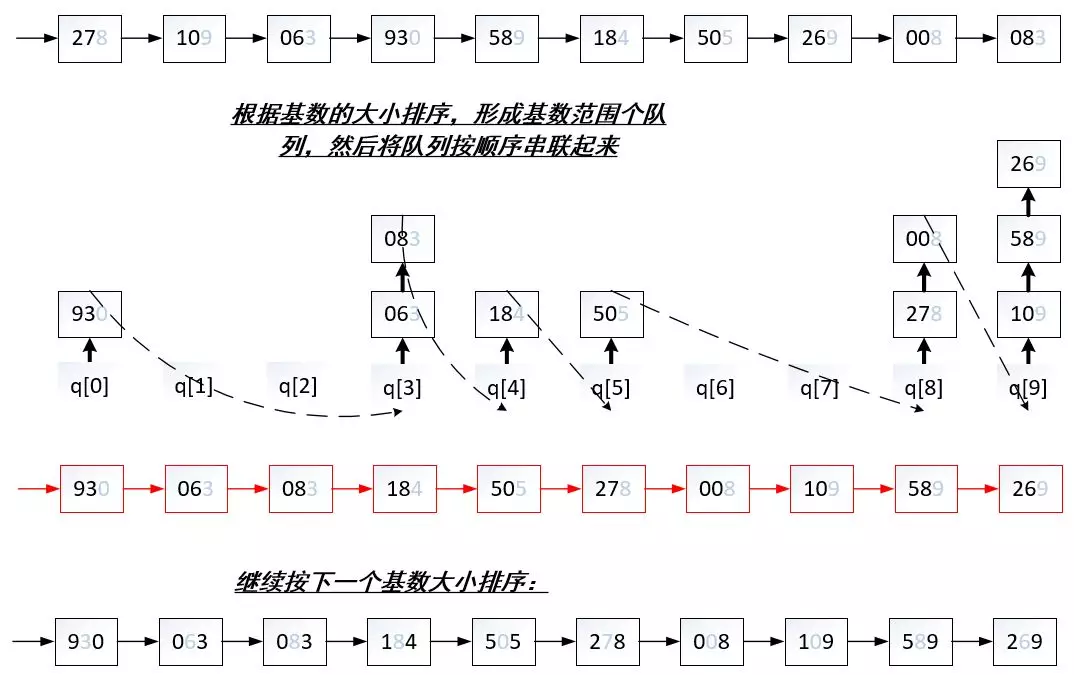
排序时有两点需要注意:
1.每完成一趟排序,要清空队列。
2.队列的连接要找到第一个不为空的队列作为头,和绕开所有空队列。
用Python实现如下:
- @staticmethod
- def radix_sort(value_list):
- """
- 基数排序
- :param value_list: 待排序的无序列表
- :return: 排序后的新列表
- """
- i = 0
- max_num = max(value_list)
- n = len(str(max_num))
- while i < n:
- # 初始化桶数组
- bucket_list = [[] for _ in range(10)]
- for x in value_list:
- # 找到位置放入桶数组
- bucket_list[int(x / (10 ** i)) % 10].append(x)
- value_list.clear()
- for x in bucket_list:
- # 放回原序列
- for y in x:
- value_list.append(y)
- i += 1
- sorted_list = value_list
- return sorted_list
测试代码:
编写测试代码运行结果如下:
- if __name__ == '__main__':
- li = list(np.random.randint(1, 1000, 30))
- my_sort = MySort()
- print("original sequence:", li)
- print("*" * 100)
- print("1.straight_insertion_sort:", my_sort.straight_insertion_sort(li.copy()))
- print("2.shells_sort:", my_sort.shells_sort(li.copy()))
- print("3.bubble_sort:", my_sort.bubble_sort(li.copy()))
- print("4.quick_sort:", my_sort.quick_sort(li.copy()))
- print("5.simple_selection_sort:", my_sort.simple_selection_sort(li.copy()))
- print("6.heap_sort:", my_sort.heap_sort(li.copy()))
- print("7.merging_sort:", my_sort.merging_sort(li.copy()))
- print("8.radix_sort:", my_sort.radix_sort(li.copy()))
测试运行结果:
- original sequence: [424, 381, 234, 405, 554, 742, 527, 876, 27, 904, 169, 566, 854, 448, 65, 508, 226, 477, 12, 670, 408, 520, 774, 99, 159, 565, 393, 288, 149, 711]
- ****************************************************************************************************
- 1.straight_insertion_sort: [12, 27, 65, 99, 149, 159, 169, 226, 234, 288, 381, 393, 405, 408, 424, 448, 477, 508, 520, 527, 554, 565, 566, 670, 711, 742, 774, 854, 876, 904]
- 2.shells_sort: [12, 27, 65, 99, 149, 159, 169, 226, 234, 288, 381, 393, 405, 408, 424, 448, 477, 508, 520, 527, 554, 565, 566, 670, 711, 742, 774, 854, 876, 904]
- 3.bubble_sort: [12, 27, 65, 99, 149, 159, 169, 226, 234, 288, 381, 393, 405, 408, 424, 448, 477, 508, 520, 527, 554, 565, 566, 670, 711, 742, 774, 854, 876, 904]
- 4.quick_sort: [12, 27, 65, 99, 149, 159, 169, 226, 234, 288, 381, 393, 405, 408, 424, 448, 477, 508, 520, 527, 554, 565, 566, 670, 711, 742, 774, 854, 876, 904]
- 5.simple_selection_sort: [12, 27, 65, 99, 149, 159, 169, 226, 234, 288, 381, 393, 405, 408, 424, 448, 477, 508, 520, 527, 554, 565, 566, 670, 711, 742, 774, 854, 876, 904]
- 6.heap_sort: [12, 27, 65, 99, 149, 159, 169, 226, 234, 288, 381, 393, 405, 408, 424, 448, 477, 508, 520, 527, 554, 565, 566, 670, 711, 742, 774, 854, 876, 904]
- 7.merging_sort: [12, 27, 65, 99, 149, 159, 169, 226, 234, 288, 381, 393, 405, 408, 424, 448, 477, 508, 520, 527, 554, 565, 566, 670, 711, 742, 774, 854, 876, 904]
- 8.radix_sort: [12, 27, 65, 99, 149, 159, 169, 226, 234, 288, 381, 393, 405, 408, 424, 448, 477, 508, 520, 527, 554, 565, 566, 670, 711, 742, 774, 854, 876, 904]
总结
各个排序效率见下图:

可以得出以下几个结论:
1.从平均时间性能而言,快速排序最佳。
2.堆排序适用于n较大的数据。
3.基数排序是稳定的,时间复杂度较大的简单排序方法也是稳定的。
4.稳定性是由方法本身决定的。
5.没有最好的排序方法,视情况而定。
- #! /usr/bin/env python3
- # -*- coding:utf-8 -*-
- # Author : MaYi
- # Blog : http://www.cnblogs.com/mayi0312/
- # Date : 2020-01-06
- # Name : mySort
- # Software : PyCharm
- # Note : 八大排序算法
- import numpy as np
- class MySort(object):
- """
- 自定义一个排序的类
- """
- def straight_insertion_sort(self, value_list):
- """
- 直接插入排序
- :param value_list: 待排序的无序列表
- :return: 排序后的列表
- """
- return self.__straight_insert(value_list)
- @staticmethod
- def __straight_insert(value_list):
- sorted_list = []
- sorted_list.append(value_list.pop(0))
- for i in range(0, len(value_list)):
- tail = True # 是否在尾部插入
- insert_loc = 0
- for j in range(len(sorted_list)):
- if value_list[i] <= sorted_list[j]:
- tail = False
- insert_loc = j
- break
- sorted_list.append(value_list[i]) # 先将值插入尾部
- if not tail:
- # 移动值
- for j in range(len(sorted_list) - 1, insert_loc, -1):
- sorted_list[j], sorted_list[j - 1] = sorted_list[j - 1], sorted_list[j]
- return sorted_list
- def shells_sort(self, value_list):
- """
- 希尔排序
- :param value_list: 待排序的无序列表
- :return: 排序后的列表
- """
- gap = len(value_list) // 2
- while gap >= 1:
- i = 0
- while(i + gap) < len(value_list):
- start = i
- gap_list = []
- while start < len(value_list):
- gap_list.append(value_list[start])
- start = start + gap
- gap_list = self.__straight_insert(gap_list)
- start = i
- while start < len(value_list):
- value_list[start] = gap_list.pop(0)
- start += gap
- i += 1
- gap //= 2
- sorted_list = value_list
- return sorted_list
- @staticmethod
- def bubble_sort(value_list):
- """
- 冒泡排序
- :param value_list: 待排序的无序列表
- :return: 排序后的列表
- """
- for i in range(len(value_list) - 1):
- for j in range(i + 1, len(value_list)):
- if value_list[i] > value_list[j]:
- value_list[i], value_list[j] = value_list[j], value_list[i]
- sorted_list = value_list
- return sorted_list
- def quick_sort(self, value_list):
- """
- 快速排序
- :param value_list: 待排序的无序列表
- :return: 排序后的列表
- """
- low = 0
- high = len(value_list) - 1
- self.__qsort(value_list, low, high)
- sorted_list = value_list
- return sorted_list
- def __qsort(self, val_list, low, high):
- """
- 快速排序辅助函数
- :param val_list: 无序列表
- :param low: 低位
- :param high: 高位
- :return:
- """
- if low >= high:
- return
- pivot_key = low
- temp_low = pivot_key
- temp_high = high
- while low < high:
- # 分成一边比轴(pivot)大,一边比轴(pivot)小的顺序
- while low < high:
- if val_list[high] < val_list[pivot_key]:
- temp = val_list[high]
- val_list[high] = val_list[pivot_key]
- val_list[pivot_key] = temp
- pivot_key = high
- break # 发生交换后,就换方向
- else:
- high -= 1
- while low < high:
- if val_list[low] > val_list[pivot_key]:
- temp = val_list[low]
- val_list[low] = val_list[pivot_key]
- val_list[pivot_key] = temp
- pivot_key = low
- break # 发生交换后,就换方向
- else:
- low += 1
- self.__qsort(val_list, temp_low, pivot_key - 1)
- self.__qsort(val_list, pivot_key + 1, temp_high)
- @staticmethod
- def simple_selection_sort(value_list):
- """
- 简单选择排序
- :param value_list: 待排序的无序列表
- :return: 排序后的列表
- """
- for i in range(len(value_list)):
- min_val = 9999999
- for j in range(i, len(value_list)):
- if min_val > value_list[j]:
- min_val = value_list[j]
- count = 0 # 如果有多个相同的最小值
- for j in range(i, len(value_list)):
- if min_val == value_list[j]:
- value_list[j], value_list[i + count] = value_list[i + count], value_list[j]
- sorted_list = value_list
- return sorted_list
- class CldSibNode(object):
- """
- 私有内部类:孩子兄弟二叉链表节点
- """
- def __init__(self, val):
- self.value = val
- self.child = None
- self.sibling = None
- def heap_sort(self, value_list):
- """
- 堆排序
- :param value_list: 待排序的无序列表
- :return: 排序后的列表
- """
- sorted_list = []
- root_node = self.CldSibNode(None)
- self.__child_sibling(root_node, value_list, 0)
- for ct in range(1, len(value_list) // 2 + 1): # 建堆
- self.__adjust_heap(root_node, len(value_list) // 2 + 1 - ct, 1)
- for i in range(1, len(value_list) + 1): # 堆排序
- sorted_list.append(root_node.value) # 输出堆顶元素
- head = root_node
- self.__shrink_heap(root_node, len(value_list) + 1 - i, 1, head)
- self.__adjust_heap(root_node, 1, 1) # 调整堆
- return sorted_list
- def __child_sibling(self, node, value_list, ind):
- """
- 创建完全二叉树的左孩子右兄弟二叉链表
- :param node: 当前节点
- :param value_list: 待排序的无序列表
- :param ind:
- :return:
- """
- if ind >= len(value_list):
- return
- node.value = value_list[ind]
- if ind * 2 + 1 < len(value_list):
- node.child = self.CldSibNode(None) # 孩子
- self.__child_sibling(node.child, value_list, ind * 2 + 1)
- if ind * 2 + 2 < len(value_list):
- node.child.sibling = self.CldSibNode(None) # 兄弟
- self.__child_sibling(node.child.sibling, value_list, ind * 2 + 2)
- def __adjust_heap(self, root_node, last_ind, now_ind):
- if not root_node or not root_node.child: # 不为空且有孩子
- return
- if now_ind == last_ind:
- # 需要调整的非终端节点
- temp = root_node
- cg = False
- while temp.child:
- if temp.value > temp.child.value:
- temp.value, temp.child.value = temp.child.value, temp.value
- cg = True # 发生交换
- if temp.child.sibling:
- if temp.value > temp.child.sibling.value:
- if cg:
- # 如果发生过交换
- temp.value, temp.child.value = temp.child.value, temp.value
- temp.value, temp.child.sibling.value = temp.child.sibling.value, temp.value
- temp = temp.child.sibling
- continue
- else:
- if cg:
- # 如果发生过交换
- temp = temp.child
- continue
- break
- # 递归
- self.__adjust_heap(root_node.child, last_ind, now_ind * 2)
- if root_node.child.sibling:
- self.__adjust_heap(root_node.child.sibling, last_ind, now_ind * 2 + 1)
- def __shrink_heap(self, root_node, last_ind, now_ind, head):
- if not root_node or now_ind * 2 > last_ind:
- # 为空
- return
- if last_ind == now_ind * 2 + 1:
- head.value = root_node.child.sibling.value
- root_node.child.sibling = None
- return True
- if last_ind == now_ind * 2:
- head.value = root_node.child.value
- root_node.child = None
- return True
- if root_node.child:
- self.__shrink_heap(root_node.child, last_ind, now_ind * 2, head)
- self.__shrink_heap(root_node.child.sibling, last_ind, now_ind * 2 + 1, head)
- @staticmethod
- def merging_sort(value_list):
- """
- 归并排序
- :param value_list: 待排序的无序列表
- :return: 排序后的新列表
- """
- i = 0
- while np.power(2, i) < len(value_list):
- count = np.power(2, i)
- start = 0
- outer_temp = []
- while start < len(value_list):
- # 定位另一边
- other = start + count
- temp = []
- if other >= len(value_list):
- # 另一边不存在:直接合并
- outer_temp.extend(value_list[start: start + count])
- break
- left, right = 0, 0
- while left < count or right < count:
- if other + right >= len(value_list):
- # 右边提前结束
- temp.extend(value_list[start + left: start + count])
- break
- elif value_list[start + left] < value_list[other + right]:
- # 左边更小
- temp.append(value_list[start + left])
- left += 1
- if left == count:
- # 左边遍历结束
- temp.extend(value_list[other + right: other + count])
- break
- else:
- # 右边更小
- temp.append(value_list[other + right])
- right += 1
- if right == count:
- # 右边遍历结束
- temp.extend(value_list[start + left: start + count])
- break
- outer_temp.extend(temp)
- start += count * 2
- value_list = outer_temp
- i += 1
- sorted_list = value_list
- return sorted_list
- @staticmethod
- def radix_sort(value_list):
- """
- 基数排序
- :param value_list: 待排序的无序列表
- :return: 排序后的新列表
- """
- i = 0
- max_num = max(value_list)
- n = len(str(max_num))
- while i < n:
- # 初始化桶数组
- bucket_list = [[] for _ in range(10)]
- for x in value_list:
- # 找到位置放入桶数组
- bucket_list[int(x / (10 ** i)) % 10].append(x)
- value_list.clear()
- for x in bucket_list:
- # 放回原序列
- for y in x:
- value_list.append(y)
- i += 1
- sorted_list = value_list
- return sorted_list
- if __name__ == '__main__':
- li = list(np.random.randint(1, 1000, 30))
- my_sort = MySort()
- print("original sequence:", li)
- print("*" * 100)
- print("1.straight_insertion_sort:", my_sort.straight_insertion_sort(li.copy()))
- print("2.shells_sort:", my_sort.shells_sort(li.copy()))
- print("3.bubble_sort:", my_sort.bubble_sort(li.copy()))
- print("4.quick_sort:", my_sort.quick_sort(li.copy()))
- print("5.simple_selection_sort:", my_sort.simple_selection_sort(li.copy()))
- print("6.heap_sort:", my_sort.heap_sort(li.copy()))
- print("7.merging_sort:", my_sort.merging_sort(li.copy()))
- print("8.radix_sort:", my_sort.radix_sort(li.copy()))
完整代码
Python - 八大排序算法的更多相关文章
- Python 八大排序算法速度比较
这篇文章并不是介绍排序算法原理的,纯粹是想比较一下各种排序算法在真实场景下的运行速度. 算法由 Python 实现,用到了一些语法糖,可能会和其他语言有些区别,仅当参考就好. 测试的数据是自动生成的, ...
- 八大排序算法的 Python 实现
转载: 八大排序算法的 Python 实现 本文用Python实现了插入排序.希尔排序.冒泡排序.快速排序.直接选择排序.堆排序.归并排序.基数排序. 1.插入排序 描述 插入排序的基本操作就是将一个 ...
- Python实现八大排序算法(转载)+ 桶排序(原创)
插入排序 核心思想 代码实现 希尔排序 核心思想 代码实现 冒泡排序 核心思想 代码实现 快速排序 核心思想 代码实现 直接选择排序 核心思想 代码实现 堆排序 核心思想 代码实现 归并排序 核心思想 ...
- 【Python】八大排序算法的比较
排序是数据处理比较核心的操作,八大排序算法分别是:直接插入排序.希尔排序.简单选择排序.堆排序.冒泡排序.快速排序.归并排序.基数排序 以下是排序图解: 直接插入排序 思想 直接插入排序是一种最简单的 ...
- 八大排序算法总结与java实现(转)
八大排序算法总结与Java实现 原文链接: 八大排序算法总结与java实现 - iTimeTraveler 概述 直接插入排序 希尔排序 简单选择排序 堆排序 冒泡排序 快速排序 归并排序 基数排序 ...
- [Data Structure & Algorithm] 八大排序算法
排序有内部排序和外部排序之分,内部排序是数据记录在内存中进行排序,而外部排序是因排序的数据很大,一次不能容纳全部的排序记录,在排序过程中需要访问外存.我们这里说的八大排序算法均为内部排序. 下图为排序 ...
- Python之排序算法:快速排序与冒泡排序
Python之排序算法:快速排序与冒泡排序 转载请注明源地址:http://www.cnblogs.com/funnyzpc/p/7828610.html 入坑(简称IT)这一行也有些年头了,但自老师 ...
- 八大排序算法Java实现
本文对常见的排序算法进行了总结. 常见排序算法如下: 直接插入排序 希尔排序 简单选择排序 堆排序 冒泡排序 快速排序 归并排序 基数排序 它们都属于内部排序,也就是只考虑数据量较小仅需要使用内存的排 ...
- python实现排序算法 时间复杂度、稳定性分析 冒泡排序、选择排序、插入排序、希尔排序
说到排序算法,就不得不提时间复杂度和稳定性! 其实一直对稳定性不是很理解,今天研究python实现排序算法的时候突然有了新的体会,一定要记录下来 稳定性: 稳定性指的是 当排序碰到两个相等数的时候,他 ...
随机推荐
- js加密(二)文书获取
时间原因直接上代码,有空再解释. js代码: //var tm=new Array(1) //tm[0]=e; ////tm[1]="%u5e72%u82e5%u4f5c%u5de5%u88 ...
- 图像滤波—opencv函数
函数原型 方框滤波 ,-), bool normalize = true, int borderType = BORDER_DEFAULT) 均值滤波 ,-), int borderType = ...
- centos7也支持service命令启动服务吗,对于centos7 中的systemctl和旧的service命令的区别和联系
一.centos7也支持service命令启动服务吗 CentOS 7.0中一个最主要的改变,就是切换到了systemd.它用于替代红帽企业版Linux前任版本中的SysV和Upstart,对系统和服 ...
- 揭秘jQuery-选择器
先看代码: $(“li”)只选择第一个无序列表中的一个li元素,而不会选择另一个无序列表中的li元素 <!DOCTYPE html> <html> <head> & ...
- javascript当中局部变量和全局变量
2)局部变量和全局变量 马克-to-win:浏览器里面 window 就是 global,通常可以省.nodejs 里没有 window,但是有个叫 global 的.例 3.2.1<html& ...
- Qt入门-表格类QTableWidget
原文 :http://blog.csdn.net/xgbing/article/details/7774737 表格是GUI中常用的控件,在Qt中,常用的表格类是QTableWidget. 示例: Q ...
- JavaWeb01-动态网页
01.动态网页的优势 动态网页是在服务器端运行的程序!随不同用户,不同条件 返回不同的结果! 001.交互性:网页会根据用户的要求和选择而动态的改变和现实网页内容! 002.自动更新:无需改变页面的代 ...
- Spring Boot框架 - 数据访问 - 整合Mybatis
一.新建Spring Boot项目 注意:创建的时候勾选Mybatis依赖,pom文件如下 <dependency> <groupId>org.mybatis.spring.b ...
- spring中@Component注解
1.@controller 控制器(注入服务) 2.@service 业务(注入dao) 3.@repository dao(实现dao访问) 4.@component (把普通pojo实例化到spr ...
- 吴裕雄 python 神经网络——TensorFlow 循环神经网络处理MNIST手写数字数据集
#加载TF并导入数据集 import tensorflow as tf from tensorflow.contrib import rnn from tensorflow.examples.tuto ...
